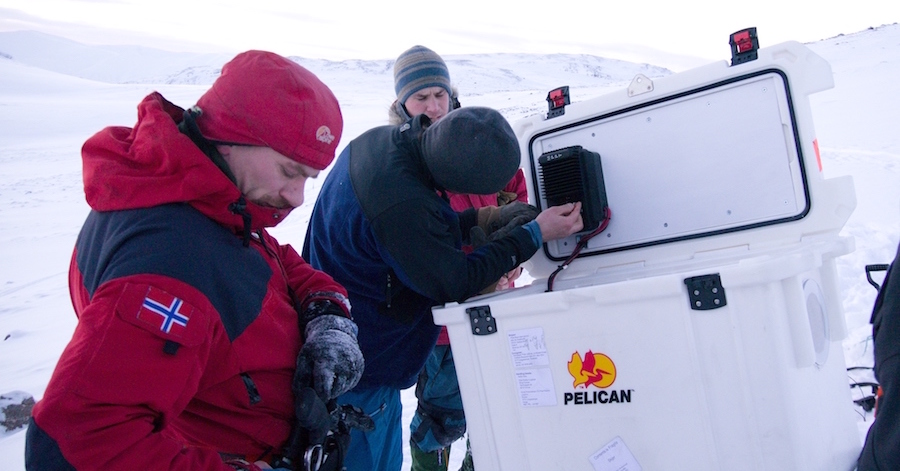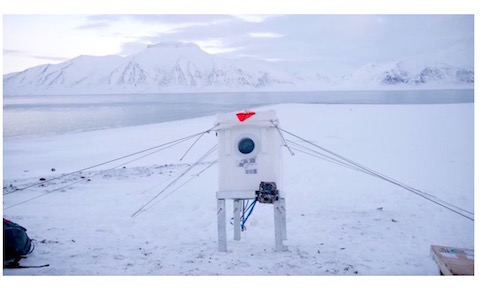
Scientists capture and analyze data to study polar bear behavior
Seagate storage products are helping a team of scientists and researchers learn more about the behaviors of polar bears and educate the public and policy makers about this threatened species.
 Polar Bears International (PBI), a not-for-profit organization that works to conserve polar bears and the sea ice they depend on for survival, uses a variety of Seagate external hard drives to store and backup several terabytes of data captured from 4K video cameras. The cameras are used primarily by research teams to monitor the activities of polar bear mothers and their cubs in parts of Alaska and Norway.
Polar Bears International (PBI), a not-for-profit organization that works to conserve polar bears and the sea ice they depend on for survival, uses a variety of Seagate external hard drives to store and backup several terabytes of data captured from 4K video cameras. The cameras are used primarily by research teams to monitor the activities of polar bear mothers and their cubs in parts of Alaska and Norway.
The researchers use AXIS surveillance cameras, which are housed in bear-resistant Pelican coolers, which offer two inches of insulation. Inside the coolers are a network-attached storage server, a solar-charge controller, a GPS network time server and of course, Seagate hard drives to capture the video footage.
Challenge of keeping data capture gear up and running
 Solar panels provide the juice to keep the equipment running, while lithium batteries maintain power during evening hours and on cloudy days. Even in an environment where outside temperatures can plunge to -40 degrees F, all of that tightly-packed gear can quickly overheat. An internal fan, along with a 7-inch sheet of plexiglass at the front of the camera box, helps keep the electronics from frying.
Solar panels provide the juice to keep the equipment running, while lithium batteries maintain power during evening hours and on cloudy days. Even in an environment where outside temperatures can plunge to -40 degrees F, all of that tightly-packed gear can quickly overheat. An internal fan, along with a 7-inch sheet of plexiglass at the front of the camera box, helps keep the electronics from frying.
“My first system hit 140-degrees F before I caught it and shut things down,” said BJ Kirschhoffer, director of field operations at PBI. “It’s not often that something is too hot in the Arctic.”
Seagate’s drives have worked flawlessly for PBI’s research team. The only issue the team has encountered is the occasional bear that can’t resist yanking on the power cables running from the solar panels to the Pelican cooler.
“We’re still working on that one,” Kirschhoffer said with a laugh.
The cameras run continuously for up to 12 weeks. A team will then helicopter in to switch everything off and pull the Seagate storage. The gear will then sit in a dormant state for another few months until another team arrives to clean up the equipment.
“Seagate’s drives have been amazing,” Kirschhoffer said. “We just plug them in and let them go. We’ve been very happy with their performance.”
Video tells many stories
Video footage stored on the drives can tell scientists a lot—when the mothers typically emerge from their dens, how long families remain at the den sites before heading to the sea ice to hunt seals, and how sensitive the animals are to disturbances in their Arctic environment.
“With these cameras, we’re able to capture data in very remote locations, showing us behavior that was previously unknown,” said Janet Stringer, development associate for PBI. “These findings will help managers and policy makers establish the best possible guidelines for protecting denning bears.”
Two-thirds of all polar bears may vanish by mid-century
PBI estimates that up to two-thirds of the world’s polar bear population could disappear by the middle of this century as global climate change melts the sea ice that’s critical to their survival. There are an estimated 26,000 polar bears today.
“We have an ecosystem, the Arctic sea ice, that’s literally disappearing from the face of the planet,” said Krista Wright, executive director at PBI.
PBI conducts a number of scientific-research projects, along with media and educational-outreach programs to heighten awareness about this threatened species and help spur legislation to improve the bears’ long-term survival odds.
PBI also uses several Seagate external hard drives to store video, films, photos and other content used in those outreach efforts with schools, zoos and other institutions. Those efforts include live-streaming forums, in which scientists discuss polar bears and the effects of climate change on their habitats and well-being.
Among the other projects PBI participates in with other scientific teams is the use of synthetic aperture radar (SAR) imaging for detecting polar bear dens, along with placing satellite collars on a selected number of bears each spring to track their movements across the Arctic.
“All of these programs generate a massive amount of data, and we store most of that data on Seagate drives,” said Wright.







